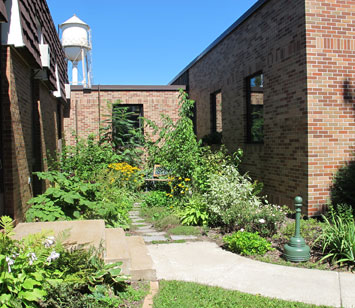Low impact Development: Putting the LID on flooding
Recent flooding serves as a reminder that upstream stormwater management efforts can reduce impacts at home and downstream.

Photo at right: Rain garden beautifies an urban space while collecting and infiltrating roof water. Photo by Jane Herbert
The effects of recent flooding were felt by large and small municipalities located on major rivers and on smaller tributary streams. Urban development often results in impervious surfaces, compacted soils and changes in natural vegetation that can reduce infiltration. Depending on the infiltration capacity of a river or stream’s floodplain, precipitation events can have cumulative effects as rain water is captured on impervious surfaces such as roads, parking lots and rooftops and delivered via storm drains to local waterways. This captured rain water, or stormwater, carries with it pollutants that have accumulated on those impervious surfaces. These pollutants may include soils and sediment, vehicle fluids, heavy metals and pet waste. A recent Michigan State University Extension article provides an overview of pollution sources.
Properly designed and applied at the local level, LID techniques such as green roofs, rain barrels, porous pavement, rain gardens and vegetated swales can help reduce cumulative impacts by capturing and slowing the release of stormwater. LID techniques may be applied in new development or may be used to retrofit aging stormwater infrastructure. They are designed for a defined volume and catchment area and may involve the use of native plants. One example is a rain garden designed to capture and infiltrate water coming off the roof of a home before it runs overland, carrying pollutants to a nearby storm drain. Rain gardens are typically smaller in size, while vegetated swales are larger and may provide both infiltration and conveyance of stormwater.
The Philadelphia Water Department’s Green City, Clean Waters initiative is a 25-year plan to save money by replacing traditional “grey infrastructure” with “green infrastructure.” Philadelphia’s goal is to integrate LID techniques on a block-by-block basis to reduce flooding, protect water quality and provide city residents with “clean, attractive, fishable, swimmable rivers and streams.” Closer to home, Grand Rapids is on the cutting edge of LID retrofit with one of the nation’s first Green Infrastructure Portfolio Standards for managing stormwater in a developed urban setting.
The U.S. Environmental Protection Agency (EPA) states that, “Applied on a broad scale, LID can maintain or restore a watershed's hydrologic and ecological functions.” LID has been characterized as a sustainable stormwater practice by the Water Environment Research Foundation and others. The Southeast Michigan Council of Governments has developed a LID manual for Michigan communities and decision makers.



 Print
Print Email
Email


